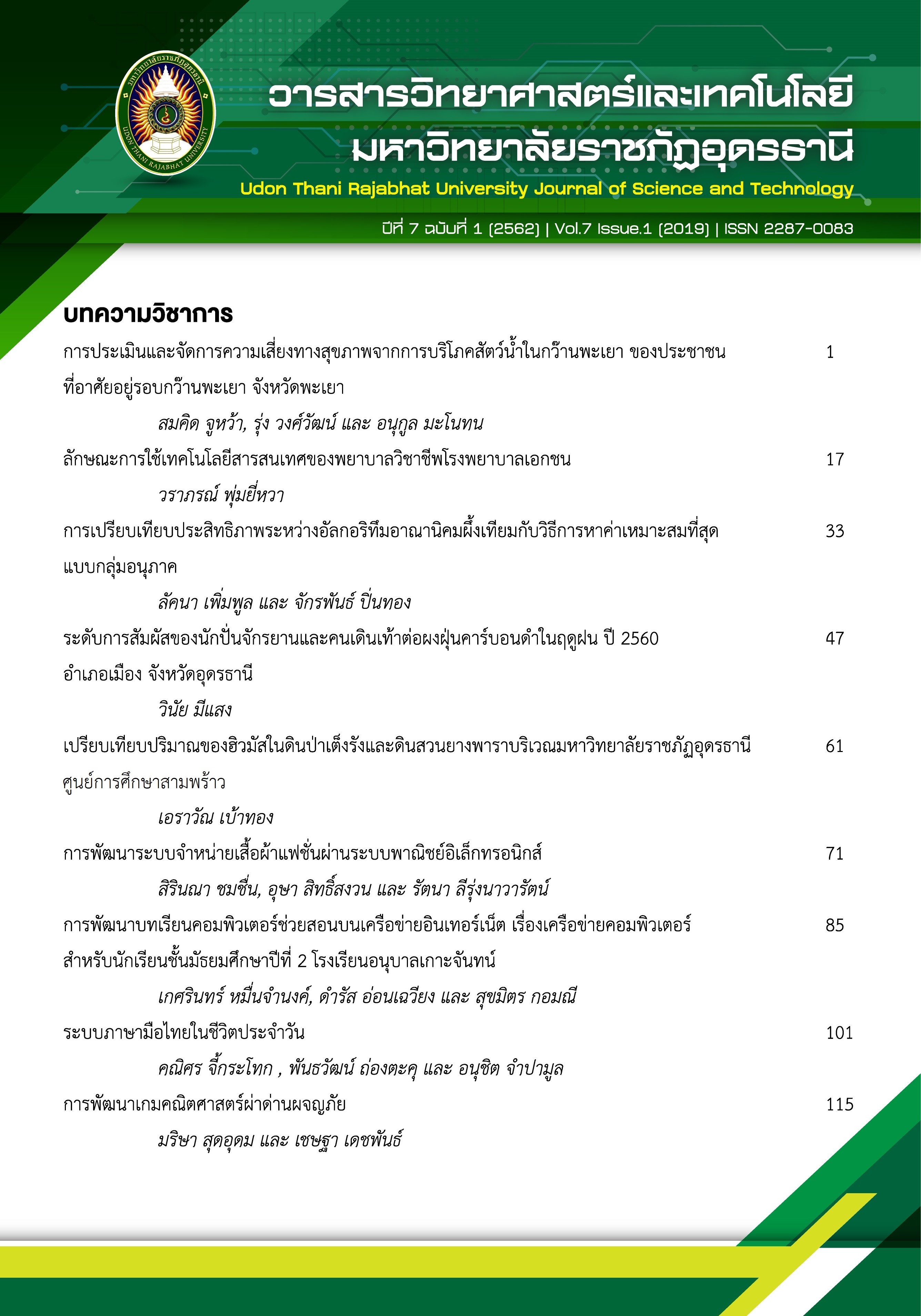Exposure Levels of Cyclists and Pedestrians to Black Carbon in 2017 Rainy Season in Muang District, Udon Thani Province
Main Article Content
Abstract
This research aimed to: 1) assess the levels of exposure to black carbon of cyclists and pedestrians during the rainy season in Udon Thani Province; 2) assess the risk of health affected by black carbon exposure in cyclists and pedestrians during the rainy season in Udon Thani Province; and 3) determine areas that are vulnerable to health problems in Udon Thani Province by studying the amount of black carbon concentration, temperature, relative humidity and traffic volume which were measured in weekdays and weekends in the rush time, between 06.00-09.00 in the morning and between 15.00-18.00 in the afternoon. These parameters were analyzed to obtain statistical data using Independent- samples T-Test. The results showed that exposure levels of the black carbon in pedestrians were higher than in cyclists during weekday morning. In contrast, the levels found in cyclists were higher than pedestrians in weekday afternoons. The measurement of the weekends showed the same results as those of the weekdays. The pedestrians risk having health problems from the black carbon more than the cyclists. The potential diseases are: an abnormal narrowing in a blood vessel, also known as stenosis (Barath et al., 2010) (Mills et al., 2005), problems of respiratory system, and lung disease (Sawant et al., 2008). Two areas in Udon Thani which were vulnerable to health problems are: in front of Wing 23 Udon Thani Air force Base and in front of fort Prachaksinlapakhom Hospital, Tahan road, Muang district. Of these areas, the traffic volume ratio per road capacity (Volume/Capacity Ratio, V/C Ratio) on weekdays was 0.88-1.00 (88-10%) while the traffic volume on the weekends was 0.67-0.88 (67-88%) in the severe traffic conditions. Comparison between the average amount of black carbon concentration during weekdays in the morning rush hour and in the afternoon indicated that the amount of black carbon concentration was not significantly different (p> 0.05). However, the amount of black carbon concentration during the weekends showed a significant difference (p= 0.002).
Article Details
References
Barath, S. et al. (2010). Impaired vascular function after exposure to diesel exhaust generated at urban transient running conditions. Particle and Fibre Toxicology, 7, 19.
Cheng, Y. H., Liao, C. W., Liu, Z. S., Thai, C. J., & His, H. C. (2014). A size segregation method for monitoring the diurnal characteristics of atmospheric black carbon size distribution at urban traffic sites: Atmospheric Environment. Sci. Procedia, 90, 78-86.
Hansen, A. D. A., Rosen, H., & Novakov, T. (1984). The Aethalometer- An Instrument for the Real-Time Measurement of Optical Absorption by Aerosol Particles. Sci. Total Environ, 36, 191–196.
Jacobson, M. Z. (2001). Strong Radiative Heating Due to the Mixing State of Black Carbon in Atmospheric Aerosols. Nature 409, 695–697.
Jacobson, M. Z. (2002). Control of Fossil-Fuel Particulate Black Carbon and Organic Matter, Possibly the Most Effective Method of Slowing Global Warming. Journal of Geophysical Research, 107(D19), 4410, DOI: 10.1029/ 2001JD001376.
Janssen, A. N. et al. (2012). Health effects of black carbon. Copenhagen: World Health Organization [WHO].
Li, Y., Henze, K. D., Jack, D., Henderson, H. B., & Kinney, L. P. (2016). Assessing public health burden associated with exposure to ambient black carbon in the United States. Science of The Total Environment, 539, 515-525.
Mills, N. L. et al. (2005). Diesel exhaust inhalation causes vascular dysfunction and impaired endogenous fibrinolysis. Circulation, 112(25), 3930–3936.
Rich, D. Q. et al. (2005). Association of Sort-Term Ambient Air Pollution Concentrations and Ventricular Arrhythmias. American Journal of Epidemiology, 161(12), 1123-1132. DOI: 10.1093/aje/kwi143.
Sawant, A. A. et al. (2008). Generation and characterization of diesel exhaust in a facility fo
r controlled human exposures. Journal of the Air & Waste Management Association, 58(6), 829–837.
Transportation Research Board. (2000). Highway Capacity Manual. National Research Council. Washington DC: Transportation Research Board Publications.
Watson, J. G. (2002). Visibility: Science and Regulation. Journal of the Air & Waste Management Association, 52(6), 628-713.


